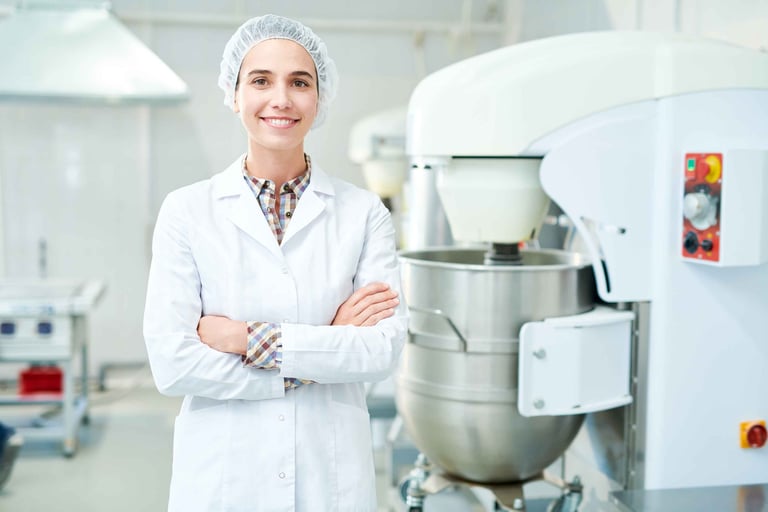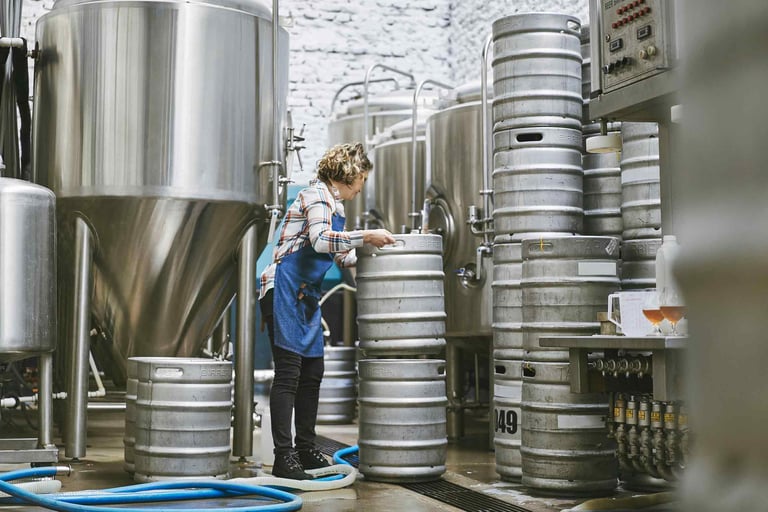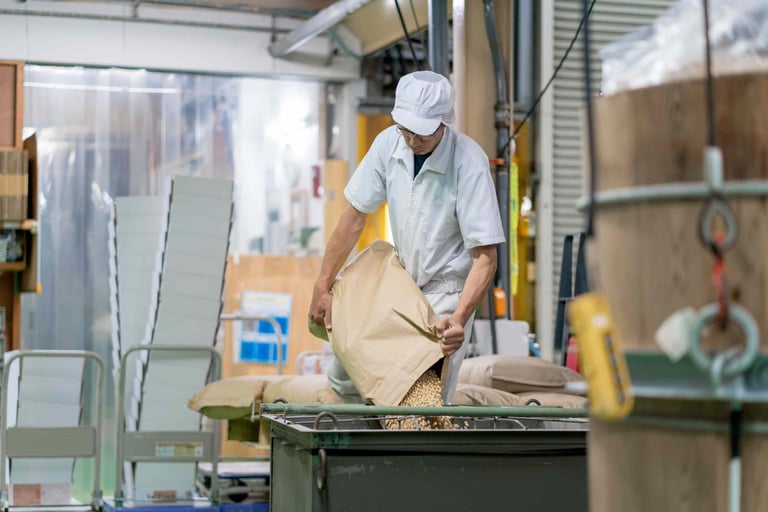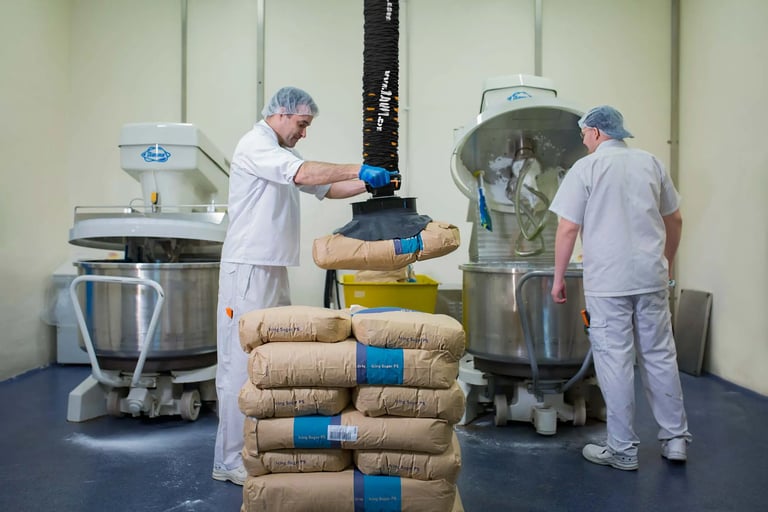Creating optimal health & safety in the food and beverage industry

Lifting operations are an integral part of the food and beverage industry. Unfortunately, they can also be a key source of injuries or workplace absence. Implementing occupational health and safety in the food and beverage industry goes far past meeting government standards and laws, it has a major impact on your business.
TAWI has years of experience in helping companies in the food and beverage industry make their moving, lifting, and sorting procedures as ergonomic, safe, and sanitary as possible – and improving the health of both your employees and your operations in the process.
Health & safety in food and beverage - a perfect lifting storm
Many assume that most manual handling injuries tend to be in typically high-risk sectors such as construction or heavy manufacturing. Such injuries, however, occur regularly in every industry.
In fact, about a fourth of all accidents that occur in the manufacturing sector occur in the food and beverage industry. More than 30% of injuries reported to the HSE in the food and drink industry are due to manual handling, such as back injuries, totalling approximately 1,700 acute injuries annually.
Manual handling in the food and beverage industry covers a wide range of activities, from handling and packaging raw materials, or moving containers on and off conveyors, to inspecting, packing and loading the final product. Many of these tasks involve steps which are potentially hazardous, such as:
- Repetitive/sustained heavy lifting
- Repetitive/sustained awkward lifting
- Repetitive/sustained posture or movement
- Exposure to sustained vibration
- Unstable/unbalanced loads
Tasks in the food and beverage industry cover a wide range, including lifting and moving heavy and bulky items such as sacks of ingredients, large drums, shrink-wrap rolls, and beer kegs. They also involve the repeated, often awkward handling of bottles, cans, unwrapped foods, liquid ingredients, and smaller, more delicate objects. This diverse array of lifting activities and loads creates a perfect storm of hazardous lifting conditions in the industry.

WIDELY KNOWN FACT: Lifting heavy items is one of the leading causes of injury – and related costs – in the workplace.
LESS WIDELY KNOWN FACT: Repetitive lifting of much smaller items can cost your company as much as heavy lifting does.
Safer lifting – from cupcakes to kegs
Like most occupations, the food manufacturing industry can be hazardous to its workers. The wide range of ingredients and packaging in the food and beverage industry all have one thing in common – the need to move them from where they are to where they need to be. A need that entails risk to both employees and products. Handling this diverse range of packaging in a safe and hygienic fashion is a constant challenge.
The injuries most frequently arising from manual handling are musculoskeletal disorders, or MSDs. This term is used to describe the various forms of damage caused by heavy, repetitive, or incorrect handling and lifting of the body’s joints, ligaments, intervertebral discs and other structures in the back. MSDs also cover injuries to joints, ligaments, tendons and nerves in the wrists, arms, shoulders, neck, abdomen and leg.
These types of injuries are also known as ‘sprains and strains’, repetitive strain injuries, or occupational overuse syndrome. Whatever they are called, whether an acute spinal injury or chronic lower back pain, MSDs can seriously and permanently affect your employee’s ability to carry out their work – and be extremely debilitating to both your workforce and your productivity.

What in the world is a WRULD?
The risk of damage to muscles and joints is not limited to particular sectors of the food and drink industry or to specific roles. And while around one-half of injuries in the food and drink industry are caused by handling and lifting heavy objects, the other half are not. Workers carrying out lighter repetitive tasks can suffer from chronic injuries, such as work-related upper limb disorders (WRULDs) which account for almost a quarter of occupational ill health.
The overexertion and cumulative trauma that result from repetitive motions such as bending, twisting, and turning are common causes of shoulder and back injuries. Strains and sprains from lifting loads improperly or from carrying loads that are either too large or too heavy to be safely managed are everyday hazards.
In fact, studies have shown that over a third of all missed workdays are the result of shoulder and back injuries, most frequently affecting the spinal region and ranging from minor strains to long-term disc problems. While the injuries resulting from the lifting and handling of heavy and/or awkward objects and repetitive, non-ergonomic lifting are often minor, in time they can have a major impact on your bottom line.
A case in point is work-related back pain, the most common MSD caused by manual handling of loads. About a quarter of European workers suffer from back pain, which tops the list of all reported work-related disorders. Prevention is vital when it comes to work-related MSDs due to manual handling. The more workers are exposed (for longer periods or higher percentage of their work time) the more likely they are to report an MSD complaint.
Top four causes of WRULDs in the food and drink industry:
- Stacking/unstacking containers
- Pushing racks and trolleys
- Packing products (such as cheese, confectionery and biscuits)
- Handling drinks containers (casks, kegs crates, etc.)
Studies have shown, however, that three-quarters of these injuries are preventable!
Vacuum technology – impacting health & safety in the food and beverage industry
Vacuum technology has long been used in the food industry to hermetically seal products, but is increasingly being used as a way to lift, move, and sort products and packages safely, quickly, and efficiently. Vacuum lifting removes the risk of careless accidents or workplace injuries caused by the often heavy and repetitive lifting required in the food and beverage industry. Any operator, regardless of size or strength, can have precise and weightless control of even the heaviest, most cumbersome bag or sack. And with no limitation on who can lift what, it is far easier to achieve workplace flexibility and diversity.
A quick checklist:
● Are your employees lifting manually without a lift assist?
● Does your business have a high rate of workers’ injury?
● Is manually lifting slowing down your workflow?
● Do you have trouble recruiting or maintaining workplace diversity?
If you answered “YES” to any of the above, it’s high time you considered implementing a vacuum assisted lifter into your workflow.
TAWI has a wide range of handling equipment developed specifically for the food and beverage industry and our solutions can streamline your entire handling process, from the receival of incoming goods to processing, packaging and palletizing. Our stainless-steel vacuum lifters allow operators to lift food with minimal effort and optimal precision while our lifting trolleys provide additional mobility – from start to finish, a safer and more productive workplace.

Many Health and Safety Managers purchase TAWI systems to reduce workplace injuries, but quickly discover a range of additional benefits, such as increased lifting ability, improved production workflow, and reduced employee turnover, giving an even greater return on their investment. The added value from a vacuum lifting solution comes from both ends of the balance sheet – reduced costs as well as higher efficiencies, productivity and profit, benefitting the entire economic well-being of a business, and improving its level of trust and reputation.
What happens at work doesn’t stay at work – and it might come back
Most are aware that creating a safer workplace, with a lower risk of injury or death, is a no-brainer. While difficult to measure sometimes, the benefits of a healthy workforce are reflected in increased productivity, lower absenteeism, improvements in talent acquisition and retention, and other areas.
Beyond the physical impact – and because of it – lies another crucial factor; the economic impact of ignoring employee safety. Work habits or procedures, whether unidentified or unresolved, cost companies huge amounts of money. Costs add up – from absence due to sickness or injury to high staff turnover and the resulting expense of retraining and loss of production, to the general lower productivity that arises from an unhappy, unhealthy workforce and the higher insurance premiums that come along with higher rates of accidents and compensation.
WIDELY KNOWN FACT: When it comes to the stock market, companies with strong health and wellness programs outperform those who don’t.
LESS WIDELY KNOWN FACT: When it comes to the factory floor, the result for companies with strong safety procedures is the same.
The hidden costs of an unsafe workplace:
- Equipment or process damage
- Downtime/loss of production
- Absence due to injury or ill health
- Additional training costs or overtime
- Damage to company reputation
- Waste of management time and resources
Employee health can impact your business as much as employee safety
The long-term negative impact of improper work habits is not always immediately apparent, but it comes home to roost. Poor health in the workplace (or injuries which are not positively managed) can become chronic concerns and create problems far into the future – not good for your employees or your performance. Long absence due to illness or injury, high employee turnover, and recruitment difficulties – all of these factors affect your business. A safe and efficient workplace makes good business sense – and so does TAWI.
TAWI safety can be your secret sauce
The key to preventing manual handling injuries in the food and beverage industry is to think – and act – both smart and safe. More and more, companies are finding that an integral part of such an approach is the use of vacuum lifting tools and solutions in order to make manual handling tasks more efficient and dramatically reduce risks and injuries. And more and more, companies are turning to TAWI to help them make their workflows safer and more effective.
TAWI has been supplying material handling equipment for the food industry for many years, and we have a thorough understanding of the special demands of this industry. Our flexible vacuum lifting solutions enable you to lift almost any type of surface or dimension quickly, safely, and hygienically. TAWI stainless-steel vacuum lifters meet the highest clinical standards and have been carefully designed to reflect the requirements of operations where sanitation and product integrity are in focus.
A TAWI ergonomic vacuum lift system:
- Grips and lifts all types of materials safely and effortlessly
- Reduces the number of employees needed for lifting and handling
- Improves workforce flexibility
- Meet the most stringent sanitary requirements
- Reduces worker injuries and saves your business money
A final word about trust
Handling food and beverages requires trust. The trust that employees have that you will not endanger their health and well-being. The trust that food companies have that sub-suppliers will ensure that no harmful substances make their way into the food products. The trust consumers have that the things they purchase are safe to eat. Achieving this level of trust places major demands on health and safety, sanitation and quality.
TAWI’s long history of supplying lifting solutions to the food industry and developing has earned us the trust of our customers. Our ergonomic solutions can be customized for almost any need and have helped a wide range of companies achieve and maintain a productive workflow, a safer workplace, and a more efficient and profitable operation.
We look forward to earning your trust as well – and helping you build a better business while doing so. Talk to a member of our team today who will be happy to help with any enquiries.
The implementation of a TAWI system reduces the risk of accidents and the consequent injuries to your workforce and your balance sheet. Our vacuum lifting solutions can help you create a workplace where employees are less likely to suffer from back sprains, muscle pulls, wrist, elbow, and spinal injuries, and less prone to injuries from accidents caused by heavy or improper lifting. In addition, a TAWI solution enables a single employee to safely and securely lift and move loads that previously required multiple employees, from the most delicate items to heavy or awkward loads which are difficult to grasp or hold.
With a TAWI vacuum lifting solution, you can reduce employee stress and fatigue, lower damage to products, and increase worker motivation and satisfaction. All of which leads to increased productivity and lower costs.